With coconut flour and almond flour, you can make pancakes, cookies, bread, muffins, pizza, and even waffles that are both healthy and delicious.
In fact, they are the feature flours for anyone following a ketogenic, paleo, low-carb, or gluten-free diet — allowing us to satisfy almost any craving without slipping back into our old eating habits.
As with any food, however, there are some crucial caveats to be aware of before using these flours.
After considering these concerns, we find coconut flour to be the “winner” of the coconut flour vs. almond flour debate in most categories. To understand why, let’s take a look at coconut flour vs. almond flour from multiple perspectives, and learn how to use both keto flours to enhance our health and weight loss results:
- What is coconut flour vs. almond flour? Their fundamental differences
- Coconut flour vs. almond flour: nutrition and net carbs
- Health benefits
- Potential health downsides
- Which one is healthier?
- Coconut flour vs. almond flour: baking and cooking essentials
- Coconut flour recipes
- Budget-friendly buying tips
- Where to buy your low-carb flour & what to look for
- How to make your own coconut flour
- How to make your own almond flour
- Coconut flour and almond flour substitutions
- Key takeaways
Coconut Flour vs. Almond Flour: What They Are and How They Are Made
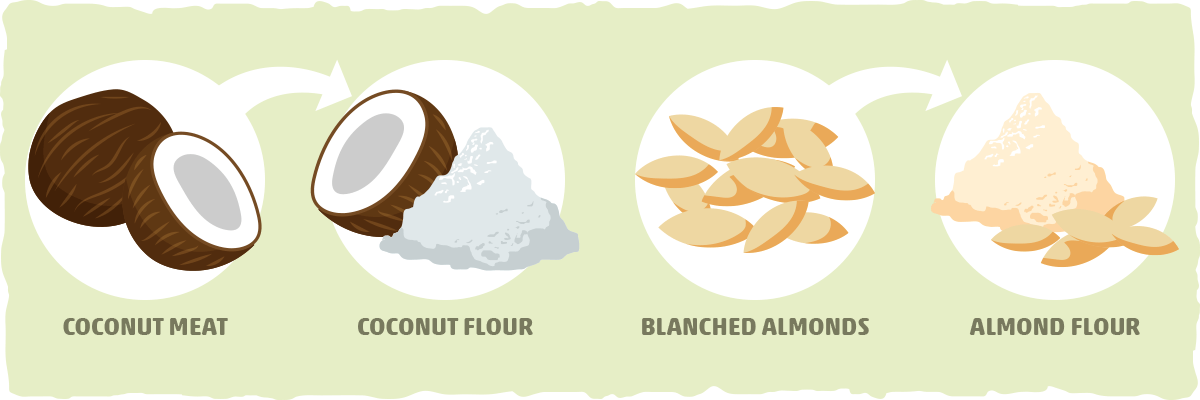
Despite being the two most commonly used low-carb flours on keto, coconut flour and almond flour have more differences than similarities, beginning with their fundamental components.
What is Coconut Flour and How is it Made?
Coconut flour is dried and finely ground coconut meat. It is often made from the byproducts of the coconut milk-making process.
Once manufacturers filter out the creamy, fat-rich coconut milk, they’re left with coconut pulp. The pulp is then dried and ground into the soft powder that we call coconut flour.
If you have access to fresh coconut meat and the right appliances, you can also make coconut milk and flour yourself. You’ll find instructions on how to do so near the end of this article.
Although many of the healthy coconut fats and minerals are filtered out during the flour-making process, you will still get many of the same benefits from coconut flour as you would from consuming the fresh coconut meat.
What is Almond Flour and How is it Made?
When recipes call for “almond flour,” they are typically referring to finely-ground, blanched almonds.
Creating this popular flour alternative involves blanching almonds in boiling water to remove the skins, then grinding and sifting them into a fine flour. The result of this process is a keto-friendly, gluten-free flour that has a slightly sweeter and nuttier flavor than regular flour.
You may also come across almond meal and unblanched almond flour. Almond meal is made by grinding almonds with their skins intact, producing a grainier flour. Almond meal products are often less expensive and can be used in recipes that don’t require a fine texture, such as muffins and cookies.
Unblanched almond flour is simply skin-on almonds that are pulverized to the same consistency as blanched almond flour. It can serve as a 1:1 substitute for blanched almond flour. However, the skins will change the color and density of baked goods, making them darker and a bit more dense than expected.
Of these three varieties, blanched almond flour is the preferred option because of its fine, smooth, and fluffy texture. It also carries the same nutritional benefits as unblanched almond flour and almond meal.
Coconut Flour vs. Almond Flour: Nutrition and Net Carbs
Below you’ll find a chart with a rough estimate of net carbs and overall macronutrient content of the most popular almond and coconut flour products:
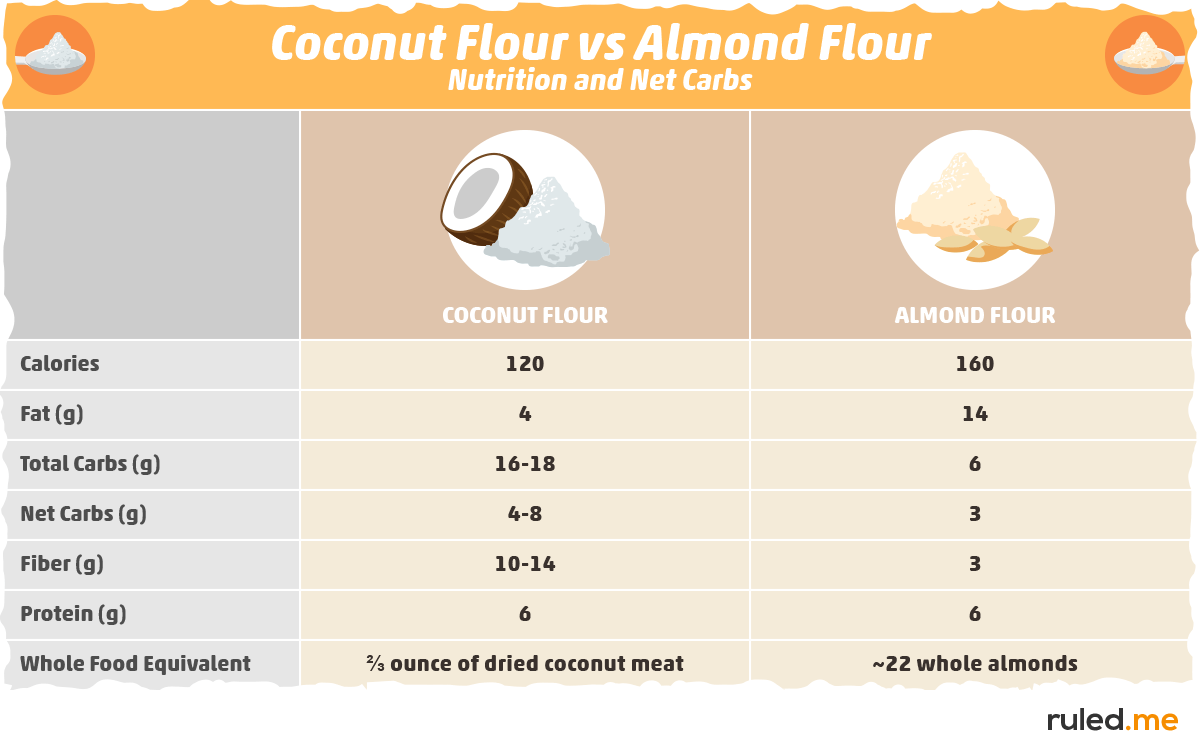
Before we use this chart to compare coconut flour vs. almond flour, we must also consider the fact that almond flour is typically used in significantly higher quantities than coconut flour. These values may vary within a couple of grams depending on the product you use. Coconut flour products have more substantial variations in their total carb, net carb, and fiber content, which is why they are represented by ranges.
In fact, the substitution ratio for these flours is a ¼ cup of coconut flour for every cup of almond flour and vice versa (while also adding or taking away liquid and eggs from the recipe). Furthermore, keto recipes that feature coconut flour will call for only a ¼ to ⅓ cup while almond flour recipes typically use 1 cup or more.
For example, one of our almond flour pancake recipes calls for one cup of almond flour while our popular coconut flour pancake recipe only requires a ¼ cup of coconut flour.
When we take this into account, a more accurate nutrient comparison of coconut flour vs. almond flour will look something like this:
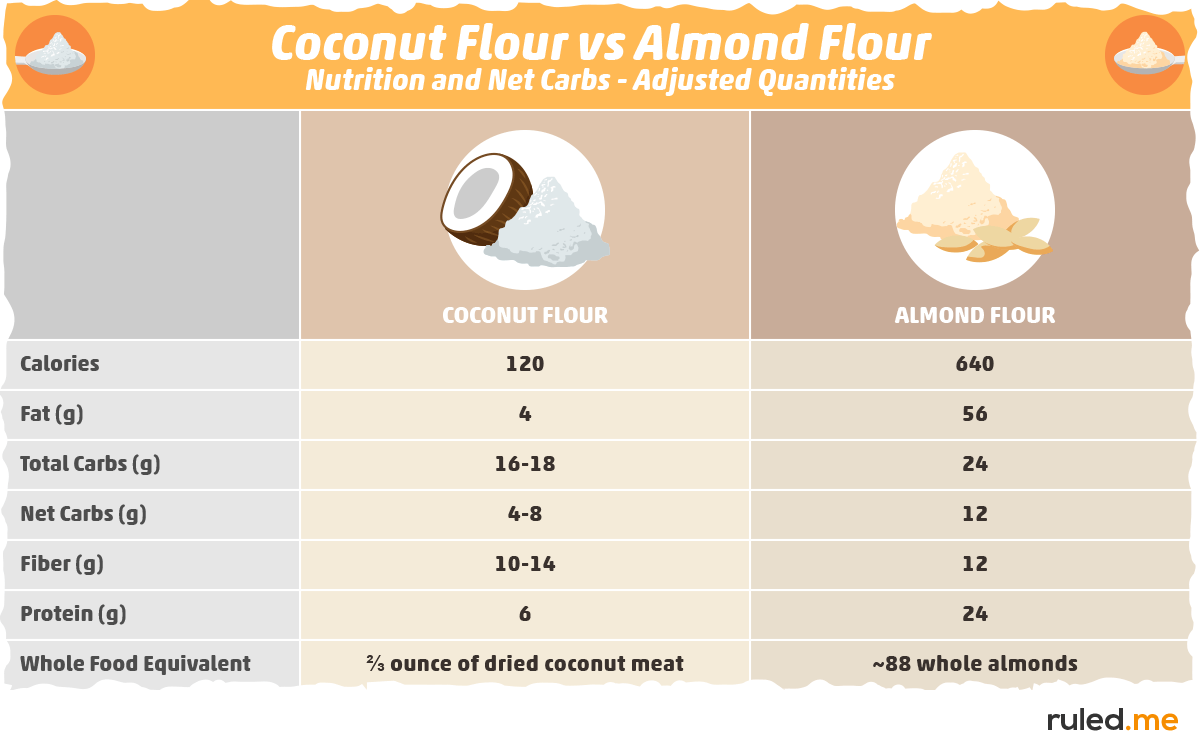
However, there is much more to health than eating the right macros, so let’s take a closer look at the other potential benefits and downsides of consuming these flours. From this perspective, coconut flour begins to emerge as the better choice, especially if you are looking to lose weight, increase your fiber intake, and keep your net carbs low.
Coconut Flour vs. Almond Flour: Health Benefits
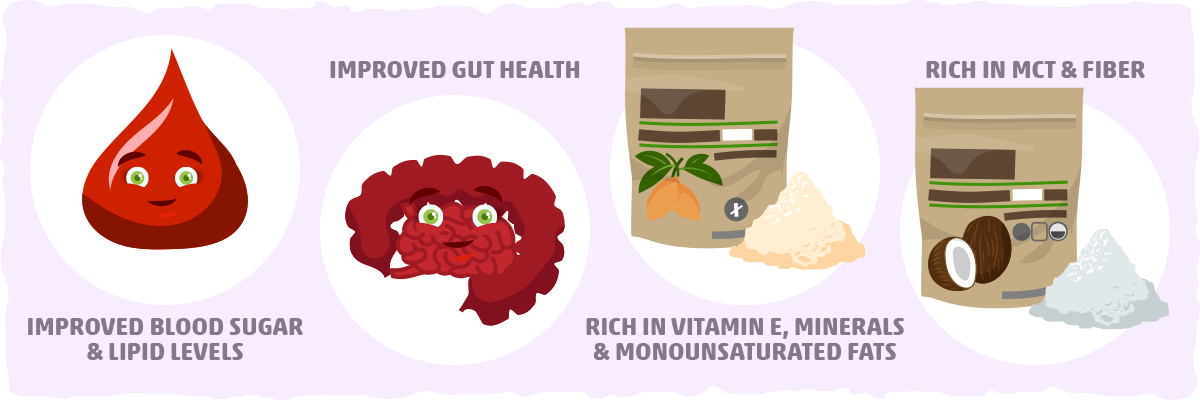
Both flours have similar benefits when used in place of wheat-based and carb-ridden flours. They are relatively high in fiber and low in carbs, making them a much healthier alternative to conventional flour.
After making the switch to these keto-friendly options, evidence suggests that blood sugar levels, blood lipid levels, and gut health can all improve significantly.
When we look at each flour in isolation, however, substantial differences arise. Almond flour, for example, is packed with vitamin E, which serves as a potent antioxidant that may help protect us from heart disease, cancer, and Alzheimer’s disease. Almonds are also a good source of monounsaturated fat (a type of healthy fat) and essential minerals including magnesium, calcium, copper, and manganese.
Coconut flour, on the other hand, isn’t as micronutrient-rich as almond flour. Many of the vitamins and minerals found in the whole coconut get filtered out during processing, leaving the flour with only trace amounts of calcium, iron, potassium, manganese, magnesium, and copper.
As with net carb and fiber content, each coconut flour product will contain varying amounts of these minerals, ranging from note-worthy numbers to barely measurable quantities.
That being said, coconut flour does provide us with high levels of medium chain triglycerides (MCTs). These fats go straight to the liver, where they increase ketone production and promote fat burning. (MCTs also provide us with several other benefits that you can learn about in our MCT oil article.)
Altogether, the combination of MCTs and fiber found in coconut flour make it helpful for increasing energy levels, promoting ketosis, and fighting off cravings.
Although almond flour is also high in fiber (and even higher in protein), it can slow weight loss because of how calorie-dense it is. Additionally, the high amounts of omega-6 fatty acids found in almonds may counteract the health-boosting benefits of their vitamin E and essential mineral content.
Coconut Flour vs. Almond Flour: Health Downsides

At first glance, almond flour may seem like a healthier choice. After all, every ounce is packed with vitamins and minerals (especially when we compare it to coconut flour).
However, many potential health risks come with consuming almond flour as well:
- Much easier to overeat. When we consider the quantities typically used in almond flour recipes, the calories from this low carb alternative can add up quickly. If you are struggling with a weight loss plateau or unexpectedly gaining weight, almond-flour-based baked goods may be one of the culprits.
- Contains high amounts of inflammation-promoting fatty acids. Almonds are packed with omega-6 fatty acids, which tend to stimulate inflammation. Many researchers suggest that eating too many omega-6s and too little omega-3s can contribute to cardiovascular disease, cancer, and autoimmune diseases. Although these fatty acids are essential, we already get plenty of omega-6 fatty acids from vegetables, nuts, seeds, meat, fish, and eggs, so limiting almond flour intake is likely the healthier option.
- May contain inactive vitamins and toxic compounds. During almond flour production, the delicate fatty acids and vitamins found in almonds may become oxidized, useless, and toxic. Almonds contain a substantial amount of volatile fats called polyunsaturated fatty acids. When exposed to heat, air, and light, they can oxidize and turn into toxic compounds. The vitamin E found in the almond can help prevent this from occurring, but excess heat exposure can render the vitamin useless. Put more simply, after processing and/or cooking/baking, almond flour is likely to have lower amounts of vitamin E and more toxic compounds than expected.
- Those with other nut allergies are typically allergic to almonds and almond flour as well. Tree nuts share many of the same proteins, so those with allergies to other tree nuts tend to also react to almonds. Coconut flour, on the other hand, rarely triggers allergic reactions in people with tree nut allergies.
- Adds extra net carbs to your recipes. On average, blanched almond flour will have roughly 12 grams of net carbs per cup. Although this is typically spread among several servings, it is crucial to be mindful of this while following a keto diet.
The potential downsides of consuming coconut flour aren’t as serious, but are still worth being cautious of:
- Adds extra net carbs to your recipes. As with almond flour, coconut flour will add some net carbs to your recipes. Make sure you take note of the carb content of the product you use because the net carbs in different coconut flours may vary significantly.
- May cause an allergic reaction for some people. Although they are more closely related to palms and only distantly related tree nuts, coconuts do have allergenic potential. The current research indicates that coconut allergies are a rare occurrence in those with tree nut allergies.
Key Takeaway: Is Coconut Flour or Almond Flour the Healthier Choice?

In comparison to conventional flours, both of these low carb alternatives are better options. However, when you compare coconut flour vs. almond flour from a health perspective, coconut flour emerges as a healthier and safer choice.
Although almond flour is a better source of vitamin E and minerals than coconut flour, these health-promoting micronutrients are accompanied by an abundance of vulnerable fats that can stimulate inflammation. Furthermore, vitamin E and fats are likely to become oxidized after processing and/or baking/cooking, rendering the vitamin useless and some of the fats toxic.
In contrast, coconut flour is lower in calories and provides us with some fiber and heat-stable, health-promoting fats. It may not be packed with micronutrients, but it is a safe, healthy, and allergen-free substitute for almond flour.
That being said, regardless of the keto flour(s) you decide to use, it should only be used in moderation. Your health transformation will come from eating primarily unprocessed, low-carb foods, not from eating a dozen keto cookies instead of the sugar-laden original.
Coconut Flour vs. Almond Flour: Baking and Cooking Essentials

Despite being keto-friendly, these two flours don’t have much in common in the kitchen. Each one has different properties and flavors that must take into account when creating a keto alternative to our high-carb favorites.
The biggest difference is that coconut flour sucks up much more moisture than almond flour. This is why recipes with coconut flour call for a lot more wet ingredients. Without the right amount of moisture, the end result will be crumbly and dry.
Because of this, you can’t substitute coconut for almond flour and vice versa without manipulating the recipe as well. Both the amount of liquid and flour will need to be adjusted to convert these recipes. (If you are looking for specific recommendations for replacing these flours, scroll down to the relevant substitution section below.)
The two flours also have slightly different tastes. Coconut has a more generic, slightly sweet flavor, while almond flour (unsurprisingly) has a distinct almond taste.
These characteristic flavors can sometimes be great — they can be delicious in cookies, pancakes, mug cakes, and keto bread recipes. However, sometimes the recipe tastes better when we mask the flavor.
If your budget allows, it is more convenient to have both flours available. Many keto recipes will call for almond flour, coconut flour, or both.
When you are first getting started, we recommend following recipes as written until you get a good feel for how each flour behaves. Once you feel comfortable using these flours, try experimenting with your own combinations and substitutions.
Since coconut flour is a bit more challenging to work with for the keto beginner, we’ve included more tips and recipes below.
Tips for Using Coconut Flour
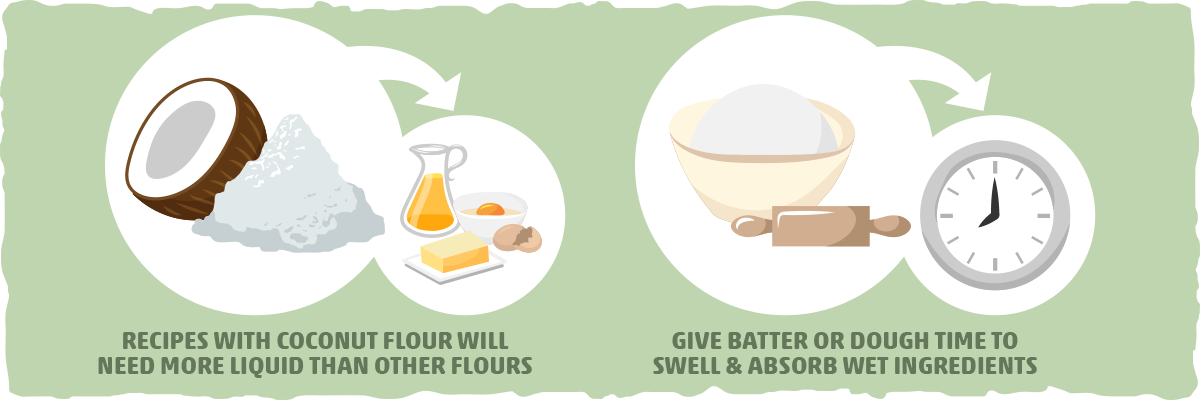
Two important things to remember when working with coconut flour are:
- Recipes with coconut flour will require much more liquid than other flours.
Because of how absorbent it is, you will need to use more eggs and liquid than you are used to while working with coconut flour. Extra eggs are required to improve the texture for better baking and to help baked goods rise.
A typical liquid/egg to coconut flour ratio for low carb recipes is 6 eggs and 1 cup of liquid for every cup of coconut flour. How much you use will vary a bit depending on what you are trying to make, but this will give you a good estimate of what this highly absorbent flour requires.
- You may need to give it time to swell and absorb the liquid before working with the batter or dough.
Coconut flour may need to settle into the batter or dough before you can tell if it is the right consistency. For example, if you were to make keto waffles or pancakes with coconut flour, you may think the batter is too runny at first. Before you think about adding more, try letting the batter rest for a minute or two to see if it thickens on its own.
To help you get familiar with these unique properties, try making some of our most popular coconut flour recipes.
Popular Keto Coconut Flour Recipes: Bread, Pancakes, Cookies, and More

High fat, low carb bread sounds paradoxical, but with the help of low carb flour, it can be done. Bread recipes that feature coconut flour tend to be very popular among keto dieters, and this is one of our favorites.
Got a chocolate craving? Give this mug cake a try. Within five minutes you will be able to experience the moist and satisfying chocolate cake that coconut flour can help create.
Most keto cookies either use almond flour or a combination of coconut and almond flour, along with a slew of other ingredients. These peanut butter cookies, on the other hand, are as simple and delicious as they sound. We rely on coconut flour here to help create the crumbly and chewy texture we expect from a classic peanut butter cookie.
When I have a pancake craving, I’ll reach for this recipe. It looks like the real thing, tastes like the real thing, and satisfies my need for this delicious temptation every time. The coconut flour in this recipe is essential for creating a pancake with the right balance of fluffiness and sweetness.
This recipe shows off the versatility of coconut flour in savory meals. Here it provides the base for the delicious coconutty layer on top of every shrimp.
To make these low carb waffles, you’ll need the keto coconut trifecta: coconut flour, coconut oil, and coconut milk. The flour, in particular, soaks up the moisture and helps bind the other ingredients together to form a thick, keto-friendly waffle batter. The result is a satisfyingly savory waffle.
Coconut Flour vs. Almond Flour: Purchasing and Budgeting Tips
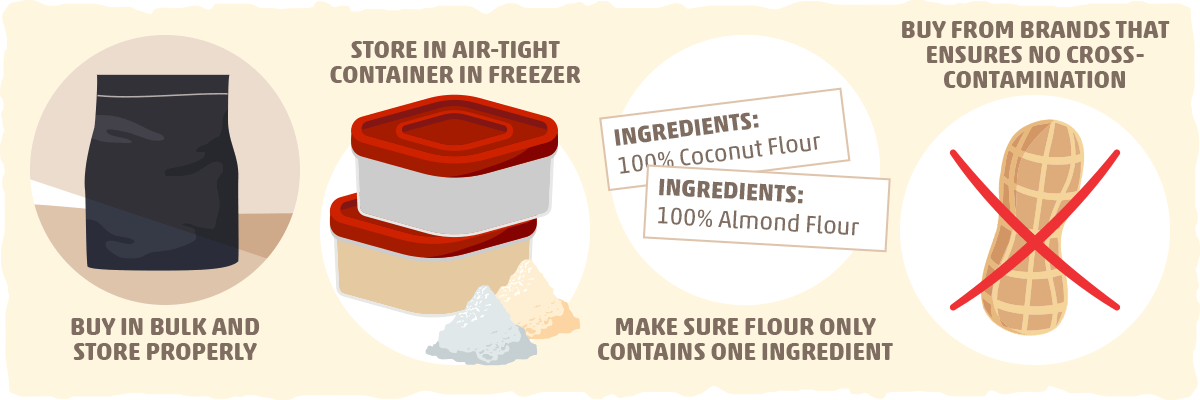
Before you purchase your preferred flour, there are a few budget-related things worth noting:
- Coconut flour is almost always cheaper (per ounce and per recipe) than blanched almond flour.
- Almond flour is used in much higher quantities in recipes than coconut flour.
- Both can be homemade at a cheaper cost in many cases.
- Coconut flour keeps longer when stored in a cool, dry place, while almond flour can become rancid more quickly (if it isn’t refrigerated or frozen).
Overall, this means that coconut flour is the better choice from a food budget perspective. By buying it in bulk and storing it properly, you can always have a high-quality keto flour that lasts you a long time without breaking the bank.
However, since almond and coconut flours are used throughout keto recipe catalog in everything from desserts to breakfast to snack, the ideal buying strategy is to purchase both in bulk and store them in an airtight container in the freezer. Some sources suggest that storing the flours in this way can extend shelf life by 6-12 months past the “best by” date.
Where to Buy Coconut Flour or Almond Flour & What to Look For
You can find coconut flour and almond flour at your favorite health food stores, certain major grocery stores that carry gluten-free flours or flour alternatives, some farmers’ markets, and through online stores. Popular retailers like Walmart, Amazon, and Costco carry these low-carb flours as well.
Once you find a coconut or almond flour product, make sure it only has one ingredient. If you see any flavorings, sweeteners, or preservatives, don’t buy it.
If you have celiac disease or a gluten sensitivity, make sure the flour is produced in a completely gluten-free facility to avoid cross-contamination.
Or, you can skip all of the flour-finding fuss and order it online using the links below:
Our recommended coconut flour products:
Our recommended almond flour products:
On the other hand, If you are looking for an alternative to buying these flours altogether, you can also make them yourself.
How to Make Your Own Coconut Flour
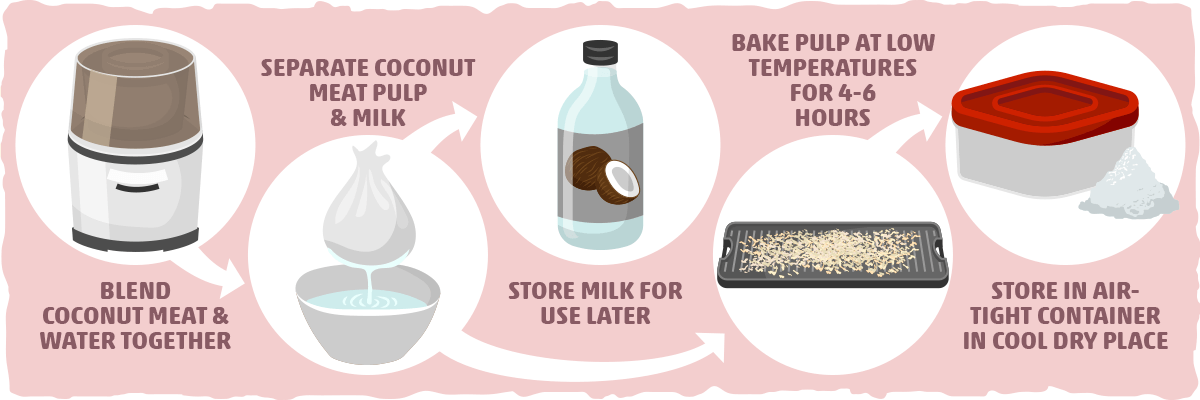
Coconut flour is one of my favorite things to make because you end up with two versatile keto ingredients: coconut milk and coconut flour. To do this, all you’ll need is fresh coconut meat, a high-speed blender, a cheesecloth, an oven (or a dehydrator), and water.
Start by blending coconut meat and water in your blender. Then, pour the mixture through a draining bag or cheesecloth to separate the coconut meat pulp from the milk.
Store your homemade coconut milk in an airtight container in the fridge, and pull it out when a keto recipe calls for it. Now you are ready to make the flour.
Spread the coconut pulp onto a baking sheet and bake it at a low temperature for several hours to dry it out. You can also use a dehydrator for this purpose, but it may take much longer. The goal here is to slowly dehydrate the coconut pulp, not cook it.
The end result should have a powdery, flour-like consistency. If you want your flour to have a finer texture, try blending it in a coffee grinder or blender after it has been dehydrated.
In summary, here is a simplified step-by-step guide of the coconut flour making process:
- Blend raw coconut meat with water.
- Use a cheesecloth or another type of straining bag to separate the milk from the meat pulp. Bottle and store the coconut milk in the fridge for later use.
- Preheat your oven at around 150 degrees Fahrenheit or prepare your dehydrator.
- Slowly dehydrate your coconut flour over the course of about 4-6 hours (or longer if you are using a dehydrator).
- Once it has turned into a fine, flour-like powder, store your homemade coconut flour in an airtight container in a cool, dry place.
How to Make Your Own Almond Flour
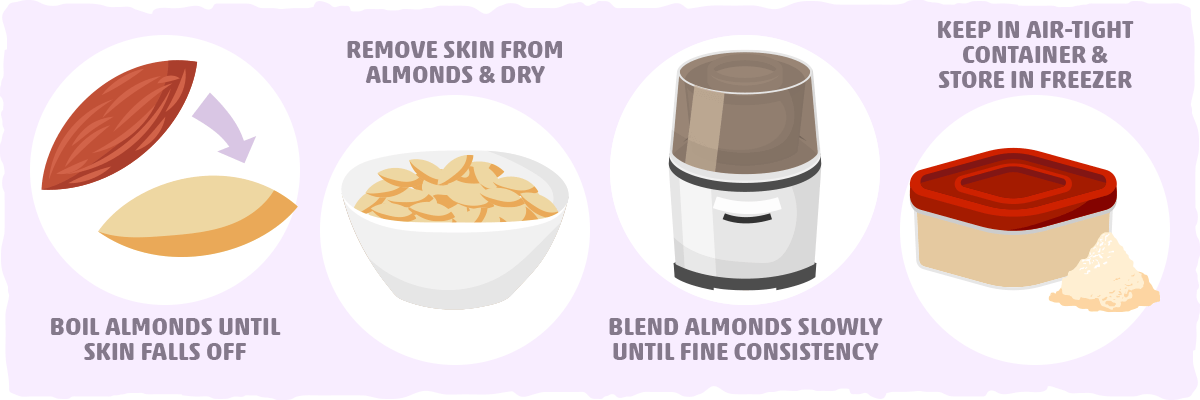
Earlier we learned about the three different almond flour products: blanched almond flour, unblanched almond flour, and almond meal. You can make each one yourself without having to spend the extra cash on almond flour.
For example, If you are running low on almond flour for baked goods like muffins and cookies, then simply throw some almonds in a food processor, make some almond meal or unblanched almond flour, and use it to replace the blanched almond flour. Just make sure you blend it as finely as possible, but not so fine that you create almond butter.
For fluffier baked goods, however, almond meal and unblanched almond flour may not yield the right consistency. This is when it is best to spend the extra time blanching the almonds and separating the skins before blending.
Here is a quick step by step guide for making your own blanched flour:
- Boil almonds for 1-2 minutes until skins fall off.
- Separate the skins from the almonds.
- Rinse in cold water and dry on a clean towel.
- Put the almond in a food processor or high-quality blender, pulsing for about 5 seconds at a time on a medium speed, then stopping to move the almonds around.
- Repeat this blending process until you have almond flour with a very fine consistency.
- Store the flour in an airtight container in the freezer.
Note: Blending the flour for too long will increase the likelihood that you’ll create almond butter. Make sure you only blend for around five seconds at a time and stop the blending process once your flour has the right texture.
How to Substitute Coconut Flour and Almond Flour
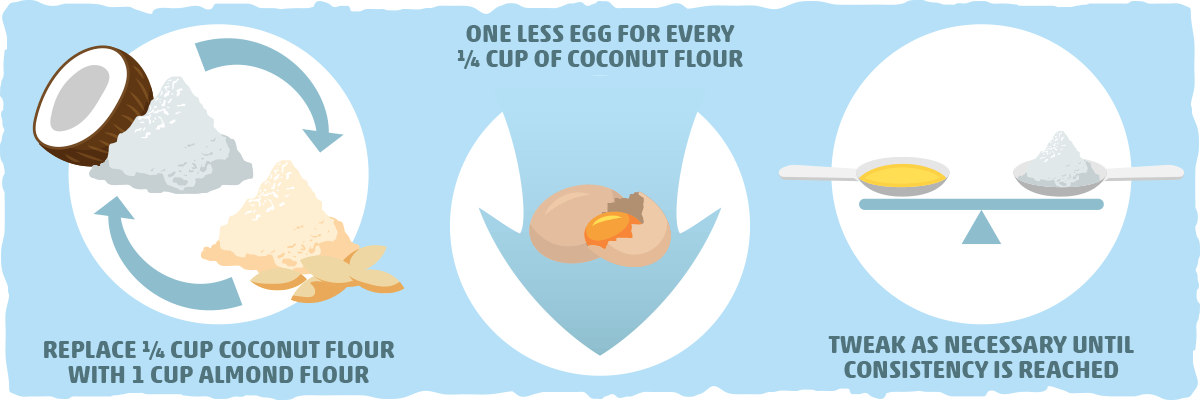
You can use almond flour as a substitute for coconut flour and vice versa, but you will have to adjust the whole recipe due to the extra absorbency of coconut flour.
To replace coconut flour with almond flour in your keto recipe, use these recommendations as a guide:
- Replace every 1/4 cup (1 ounce) of coconut flour with at least 1 cup of almond flour.
- Decrease the amount of liquid in the recipe by using one less egg for every 1/4 cup of coconut flour that the recipe initially called for.
For those of you who would like to substitute coconut flour for almond flour, you’d use these same ratios. For example, you’d replace every cup of almond flour with a ¼ cup of coconut flour and add one egg to the recipe for each ¼ cup.
You may also need to manipulate the liquid content of the recipe as well. If your mixture seems too dry, add more liquid — little by little — until you get the right consistency. Conversely, if your batter is too wet, add coconut flour one teaspoon at a time until you get the right consistency.
For more information about keto-friendly flours and how to use them, check out our article on keto flour substitutions.
Other Almond and Coconut Flour Substitutes: 100% Nut-free options
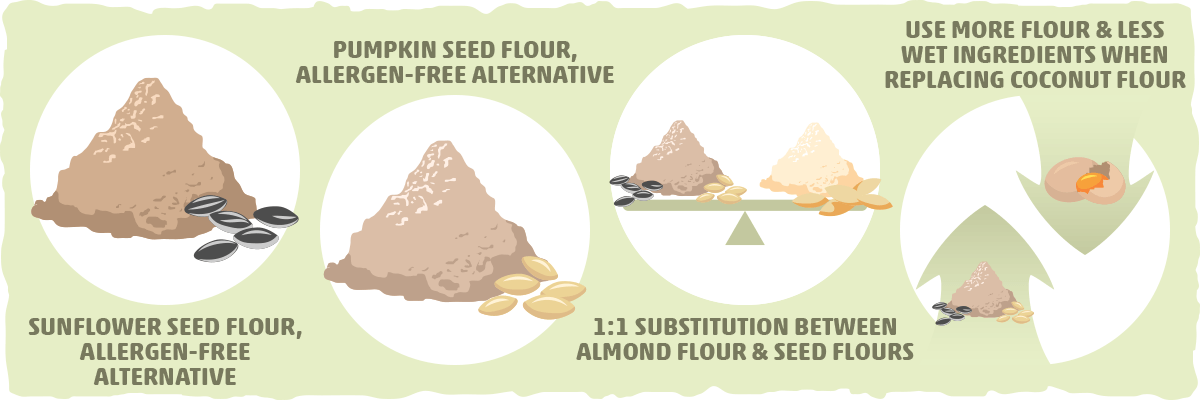
If you are allergic to these keto flours or don’t have any available, your best option is to find a keto-friendly recipe that doesn’t require either one. For example, you can make a delicious keto bread without any low-carb flours (you can find the recipe here).
Your next best option is replacing coconut flour or almond flour with sunflower seed or pumpkin seed flour. These allergen-free alternatives solely consist of pulverized seeds and can be used to make all of your keto-friendly favorites.
To replace almond flour/meal, you would use the same amount of sunflower seed or pumpkin seed flour. This 1:1 substitution can be done because these seed flours share many properties with almond flour. (The only striking difference between them is that sunflower seed flour may add a green hue to your baked good.)
If you are looking to replace coconut flour with sunflower seed or pumpkin seed flour, then you will need to use more flour and less liquid than the recipe calls for. Find the ideal ratio by adding small amounts of seed flour and liquid until you get the right consistency. You will end up using roughly the same substitution ratios as you’d use to replace coconut flour with almond flour.
Putting It All Together — Coconut Flour vs. Almond Flour for Keto
Almond flour and coconut flour are healthy, gluten-free alternatives to carb-ridden, conventional flours. However, when you compare them directly, several significant differences begin to surface.
In most aspects, these two keto-friendly flours are so unique that they shouldn’t be mentioned synonymously. To get a better understanding of coconut flour vs. almond flour, here is a graphic that summarizes their key characteristics from various perspectives:
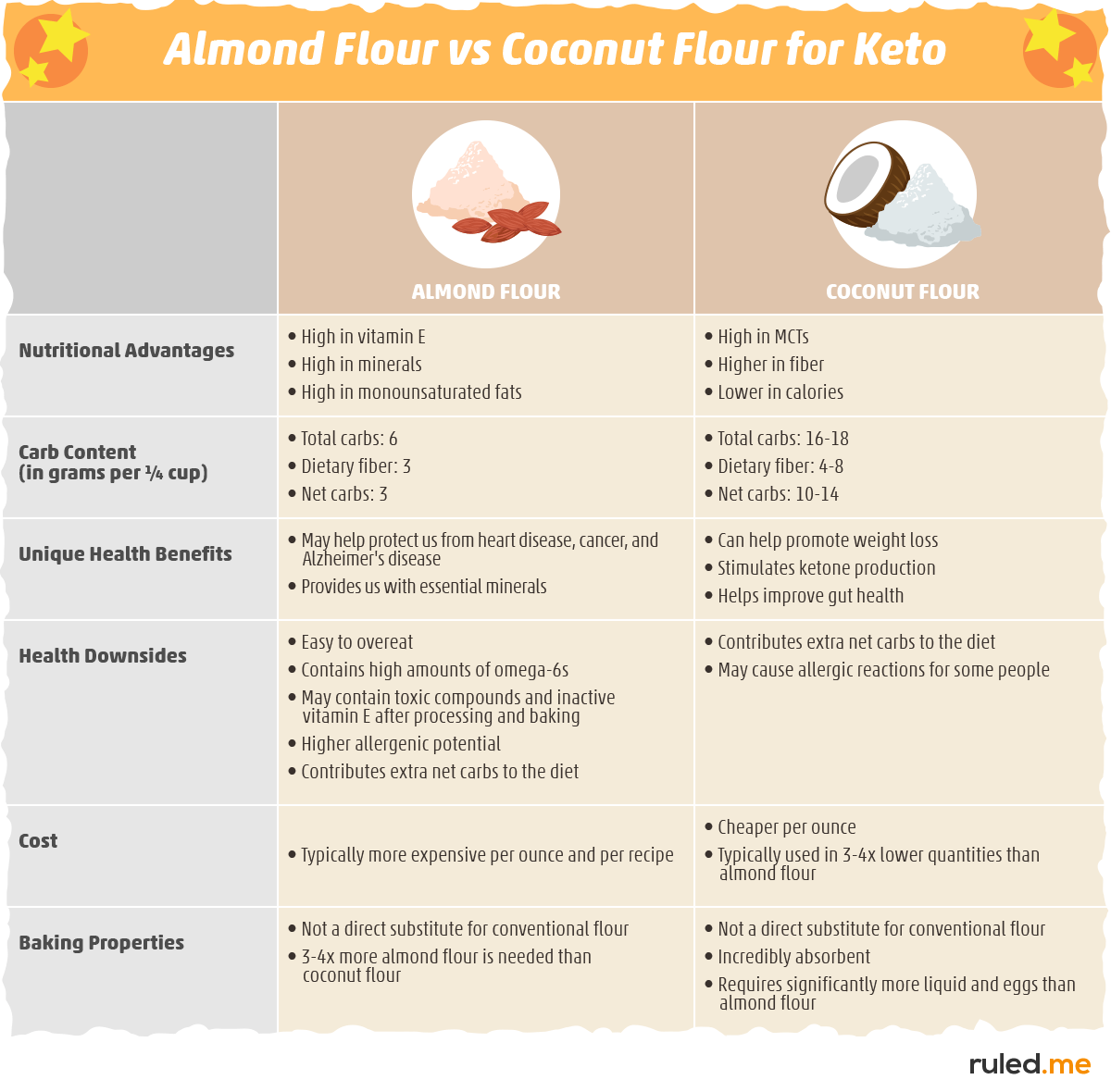 Overall, coconut flour emerges as a healthier and cheaper option. However, it may take some time before you get a feel for how to use it on keto. To help you become a coconut flour connoisseur, try making some of these delicious keto recipe to see some amazing results:
Overall, coconut flour emerges as a healthier and cheaper option. However, it may take some time before you get a feel for how to use it on keto. To help you become a coconut flour connoisseur, try making some of these delicious keto recipe to see some amazing results:
- Keto Bread Loaves
- Coconut Flour Chocolate Keto Mug Cake
- Classic Peanut Butter Cookies
- Fluffy Coconut Flour Pancakes
- Mini Pumpkin Spice Muffins
- Savory Sage and Cheddar Waffles
- Jalapeno Cheddar Waffles
- Italian Cheesy Bread Bake
- Low Carb Coconut Shrimp
- Keto Coconut Cream Pies
While you are making the shift from unhealthy flours to keto-friendly alternatives, remember to fit these changes into the broader context of your overall keto diet and lifestyle.
These keto flours should be used in moderation, making up only a small part of a well-formulated ketogenic diet that helps you improve your health and reach your body composition goals. If you need help getting started, check out our comprehensive guide to keto.
Sources
- Keto Flour Substitutions — Ruled.me
- The importance of the ratio of omega-6/omega-3 essential fatty acids. — NCBI
- Why Almond Flour Is Better Than Most Other Flours — Healthline
- USDA Nutritional Database — USDA
- Coconut allergy — Anaphylaxis
- Effect of different cooking methods on the content of vitamins and true retention in selected vegetables — NCBI
- FACTS AND STATISTICS — FARE
- What is Polyunsaturated Fat? The Truth About This “Healthy” Fat — Ruled.me
- Thermal Stability of Vitamin E in Barley — Food Science and Technology
- Are Omega-6s Healthy or Unhealthy? — Ruled.me
- MCT Oil: The Benefits, Risks, and How to Use — Ruled.me
- Low Carb Flour: Baking with Coconut Flour & Almond Flour — Atkins
- Does Almond Flour Go Bad? — Does It Go Bad
- Does Coconut Flour Go Bad? — Does It Go Bad